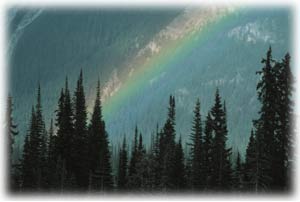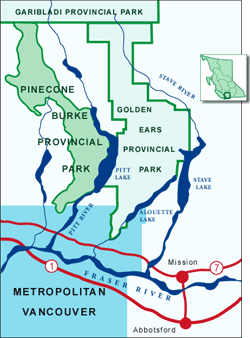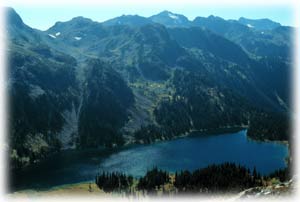|
|
|
|
|
|
|
 Pinecone Burke Provincial Park is a beautiful wilderness area with the unique characteristic of being located on the edge of the densely populated Lower Mainland area of British Columbia. It is a park full of distinctive features: Pitt Lake is the largest fresh water tidal lake in North America and Widgeon Slough is the largest freshwater marsh in southwestern British Columbia. As well, Widgeon Lake is the largest hanging lake in the North Shore mountains of the Lower Mainland. The 38,000 ha (94,000 acre) park contains extensive old-growth forests, several smaller alpine lakes and rough peaks capped in places by glacial ice. Visitors to Pinecone Burke Park will delight in the wild natural landscape they can experience within a short drive of downtown Vancouver. Pinecone Burke Provincial Park is a beautiful wilderness area with the unique characteristic of being located on the edge of the densely populated Lower Mainland area of British Columbia. It is a park full of distinctive features: Pitt Lake is the largest fresh water tidal lake in North America and Widgeon Slough is the largest freshwater marsh in southwestern British Columbia. As well, Widgeon Lake is the largest hanging lake in the North Shore mountains of the Lower Mainland. The 38,000 ha (94,000 acre) park contains extensive old-growth forests, several smaller alpine lakes and rough peaks capped in places by glacial ice. Visitors to Pinecone Burke Park will delight in the wild natural landscape they can experience within a short drive of downtown Vancouver.
|

Pinecone Burke Provincial Park is exceptional in that this wild and remote feeling landscape is in fact located very near the heavily populated Lower Mainland of British Columbia. The park extends from the boundary of Garibaldi Provincial Park in the north, to Burke Mountain in Coquitlam in the south. To the west lies Pitt Lake and the Pitt River.
Since it is mostly surrounded by heavily populated areas, Pinecone Burke Park may be easily accessed from a variety of locations. From the south, into the Burke Mountain Area, follow Coast Meridian Road in Port Coquitlam to Apel Drive; this will turn into Victoria Drive, and then lead onto Quarry Road. Alternatively, trails and old logging roads leading to Munro and Dennette Lakes and Burke Ridge enter the area from the end of Harper Road, near the Port Coquitlam and District Hunting and Fishing Club.
From the west the park is reached by following rough gravel roads through the Mamquam and Indian River Valleys. Access by boat is possible through Widgeon Slough to Widgeon Valley, and through West Pitt Lake to the DeBeck Valley.

Click on the map to view an enlargement
|

Pinecone Burke Provincial Park is an excellent place for hiking, with many marked and maintained trails linking various picturesque lake and alpine locations. Along these trails and throughout the park there are designated and semi-maintained backcountry campsites available on a first-come first-serve basis. Burke Mountain is one of the more popular destinations within the park. While there are no maintained facilities or campsites on Burke Mountain, wilderness camping is permitted so long as it is done in a fashion that is not damaging to the ecosystem.
Another favourite location is Widgeon Creek Campsite, where there are 6 maintained sites, with an overflow area established in the adjacent meadows. This site is reached by paddling a canoe or kayak for about two hours from Grant Narrows at the south end of Pitt Lake, through Widgeon Slough and into the Widgeon Valley. BC Parks maintains the area, which hosts an information board, 6 camp tent pads, signage and a food-bear cache; visitors should be prepared to pack out all of their garbage with them, and to practice no trace camping. Backcountry camping is also found at three marine campsites along the shores of Pitt Lake: Defrauder Falls, Osprey Creek, and Raven Creek.
Boating, canoeing and kayaking are all popular forms of recreation in Pinecone Burke Provincial Park, especially on Pitt Lake, Widgeon Slough and Widgeon Creek. Several campsites, as well as day use areas can be reached from the water.
Due to its extensive waterways, especially Widgeon Slough, bird watching is particularly good in Pinecone Lake Provincial Park. Fishing is also possible, with Pitt Lake being renowned for its cutthroat trout. Anglers are reminded that they require a valid fishing license in order to fish in British Columbia.
|
|
"Pinecone Burke Provincial Park is an excellent place for hiking, with many marked and maintained trails leading between various picturesque locations."
|

 Since it contains valuable wetland and waterway habitat as well as a range of terrestrial ecosystems, from valley bottom to mountaintop, Pinecone Burke Provincial Park is home to an interesting variety of species. All 5 species of Pacific salmon (Chinook, sockeye, chum, coho and pink) are found in the park's waters, along with cutthroat trout, steelhead and Dolly Varden. Widgeon Valley is of particular note for its nationally recognized wetlands. On land, species found include grizzly bears, black bears, mountain goats and black-tailed deer. Since it contains valuable wetland and waterway habitat as well as a range of terrestrial ecosystems, from valley bottom to mountaintop, Pinecone Burke Provincial Park is home to an interesting variety of species. All 5 species of Pacific salmon (Chinook, sockeye, chum, coho and pink) are found in the park's waters, along with cutthroat trout, steelhead and Dolly Varden. Widgeon Valley is of particular note for its nationally recognized wetlands. On land, species found include grizzly bears, black bears, mountain goats and black-tailed deer.
|
"Since it contains valuable wetland and waterway habitat as well as a range of terrestrial ecosystems, from valley bottom to mountaintop, Pinecone Burke Provincial Park is home to an interesting variety of species."
|

The land and water that makes up Pinecone Burke Provincial Park has long been part of the area inhabited and utilized by the Katzie First Nation. The Katzie people especially valued the area's plant, fish and wildlife resources.
After Europeans arrived in British Columbia the site began to attract mountain climbers, especially to the Five Fingers area north of Widgeon Lake, and in the 1920s many of the areas peaks were climbed for the first time. Later on, logging and mining occurred in the area. These activities are evidenced by old, abandoned mine tunnels and donkey engines found west of Pitt Lake.
The creation of Pinecone Burke Provincial Park was a result of the work of conservationists in the Coquitlam area, who formed the Burke Mountain Naturalists. These dedicated local citizens, spearheaded especially by John Cashore (who later became Minister of Parks in the 1990s) and Mark Haddock, had been proposing for decades the protection of this area.
During the 1990s, when the NDP government of the day moved forward with the Protected Areas Strategy; the Burke Mountain Naturalists were successful in getting Pinecone Burke included. In the lead up to its protection though, there were proposals to log the old growth forests of Boise Valley in the Upper Pitt Valley. This led to major public outcry including large rallies held by Western Canada Wilderness Committee, which provided the final incentive for government to protect beautiful Pinecone Burke Provincial Park.
"After Europeans arrived in British Columbia the site began to attract mountain climbers, especially to the Five Fingers area north of Widgeon Lake, and in the 1920s many of the areas peaks were climbed for the first time."
|
|
Return to the Cascades Region
Become Involved!

|
|

